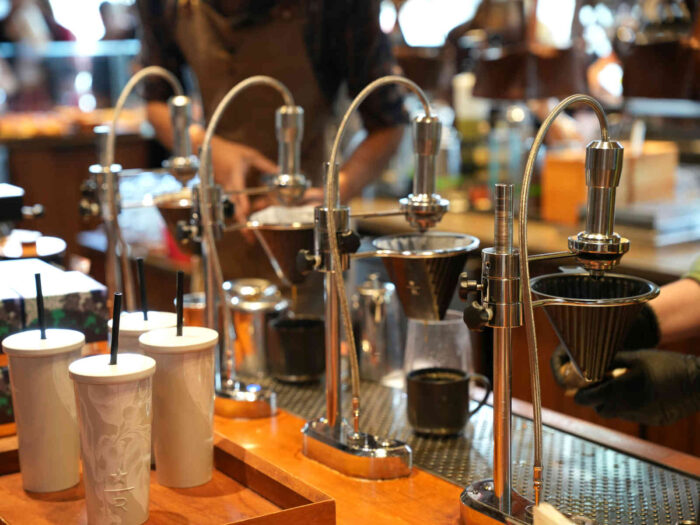
This SWOT analysis of Starbucks examines business strengths for overcoming weaknesses, exploiting opportunities, and protecting the company against threats and barriers to success in the global market.
This SWOT analysis considers Starbucks’ strengths and weaknesses (internal strategic factors) inherent in the coffee and coffeehouse business. This business analysis case also considers the opportunities and threats (external strategic factors) related to the competitive landscape determined in the Five Forces analysis of Starbucks.
Competition and the factors in this SWOT analysis require that the company continuously improve its business strengths to optimize its financial performance and multinational growth trajectory.
Strategic planning accounting for this SWOT analysis can increase Starbucks’ success against competing coffeehouses and foodservice businesses, like Tim Hortons, Dunkin’, McDonald’s, Subway, Burger King, and Wendy’s.
In the business environment in this SWOT analysis, Starbucks uses strategies and competencies for various markets and products. Starbucks’ marketing mix or 4P indicates product mix expansion including coffee, tea, food, and merchandise.
Starbucks’ Strengths (Internal Factors)
This SWOT analysis component deals with internal factors that the coffeehouse business uses as strengths. Considering its business competencies and competitive advantages, organizational size, and global market presence, Starbucks’ strengths are:
- Strong coffee and coffeehouse brand image
- Effective global supply chain management capabilities for coffee, etc.
- Moderate diversification through subsidiaries and products
Starbucks is one of the world’s strongest and most popular brands. The company has a growing population of loyal customers, which adds to the stability of the coffeehouse business linked to brand value and popularity.
In the SWOT analysis model, effective capabilities for managing a global supply chain strengthen Starbucks by supporting operations that connect production (e.g., Arabica coffee beans in plantations) to consumption (e.g., caffeinated drinks in coffeehouses).
Also, the company gradually diversifies its business through new products and new subsidiaries, resulting in the current product mix and brands of Starbucks, Ethos Water, and others. Diversification makes the effects of market and industry risks on Starbucks’ coffee business more manageable.
The internal strategic factors in this part of the SWOT analysis show that the business has strengths that promote resilience through diversification and a global supply chain for the achievement of business goals derived from Starbucks’ mission statement and vision statement.
Starbucks’ Weaknesses (Internal Factors)
Business weaknesses are identified in this component of the SWOT analysis. Weaknesses are internal factors that reduce or limit the capabilities of the coffeehouse company. Starbucks’ weaknesses are as follows:
- Pricing strategy for high price points
- Generalized standards for most products
- Imitability of products, especially beverages
Starbucks has high price points that maximize profit margins but reduce the affordability of some of its products. The related pricing strategy, an internal strategic factor, is a weakness because it limits the coffee company’s market share, especially in areas with relatively lower disposable incomes.
Also, this SWOT analysis considers Starbucks’ generalized standards a weakness that limits the flexibility of the coffeehouse chain’s business organization. For example, the company’s generalized standards for crafted beverages reduce these products’ cultural alignment with local target markets and consumer preferences.
In addition, many Starbucks products are imitable. For instance, small local competitors can develop beverages like the company’s products. Even the design and ambiance of the company’s cafés are imitable. Imitability is a weakness that empowers competitors.
The internal factors in this part of the SWOT analysis of Starbucks Coffee Company show that the business must develop strengths to reduce the adverse effects of imitation and high price points on the company’s market share in the global industry.

Opportunities for Starbucks (External Factors)
This part of the SWOT analysis model focuses on external factors that present opportunities for business growth and development. In this case, the main opportunities available to Starbucks are as follows:
- Further expansion in developing markets
- Higher business diversification to include operations related to food, beverages, and merchandise
- Stronger market position through additional partnerships or alliances
Starbucks Corporation can increase its revenues by increasing its operations in developing markets, many of which have high economic growth rates. This opportunity draws attention away from the U.S. market, where most of the coffeehouse company’s revenues are generated.
Also significant in this SWOT analysis is higher business diversification, which can improve Starbucks’ long-term stability. For example, further diversification can reduce the coffee company’s dependence on a single market, market segment, or industry, thereby reducing risks and improving revenue growth opportunities.
Although it supports the expansion of the multinational coffeehouse business, diversification is currently a minor growth strategy, as shown in Starbucks’ generic competitive strategy and intensive growth strategies.
The industry environment considered in this SWOT analysis also presents the opportunity to strengthen the company’s market position through additional partnerships or alliances with other firms. For instance, additional or reinforced alliances with major retailers can improve the distribution and market share of Starbucks’ consumer goods, such as ready-to-drink coffee.
The external strategic factors in this part of the SWOT analysis show that Starbucks can improve its industry position by exploiting the opportunities, such as diversification and alliances in the global industry environment.
Threats to Starbucks (External Factors)
Threats to the coffeehouse business are identified in this part of the SWOT analysis. These threats are external factors that reduce or limit business performance. In this company analysis case, the following are the main threats relevant to Starbucks:
- Competition with low-cost coffee sellers
- Imitation of name, design, or recipes
- Independent coffeehouse movements
Starbucks Corporation competes with many firms in the international market. For example, the company’s products compete with lower-cost coffee products from restaurant chains, like McDonald’s and Dunkin’. This external strategic factor threatens Starbucks because such competitors can reduce the company’s market share by competing based on low prices.
Also, this SWOT analysis considers imitation as a threat to the coffeehouse business. This threat of imitation involves firms that try to copy the taste, look, and feel of Starbucks products and the design of the company’s coffeehouses.
In addition, the industry environment is subject to independent coffeehouse movements. These movements are sociocultural efforts that support the operations of small independent local coffeehouses and oppose the expansion of multinational coffeehouse chains, like Starbucks.
Such sociocultural trends influence consumer perception and purchasing behaviors, as shown in the PESTEL/PESTLE analysis of Starbucks. Successful marketing campaigns and branding strategies are needed to counteract the effects of these trends.
This part of the SWOT analysis of Starbucks Coffee Company identifies external strategic factors that impose challenges to international expansion and market penetration. These challenges may require shifts in Starbucks’ business strategies or policies.
Recommendations – SWOT Analysis of Starbucks
The industry environment of Starbucks involves diverse challenges, especially because of the company’s moderate diversification. The coffeehouse chain business faces issues, such as competition in various markets.
Based on the current condition of the business, some of the most notable strategic management concerns enumerated in this SWOT analysis of Starbucks Coffee Company are the imitability of products and the corresponding threat of imitation, the threat of competition involving low-cost sellers, and independent coffeehouse movements.
Recommendation 1. Based on this SWOT analysis, a recommendation for protecting Starbucks’ business against imitation is to aggressively innovate, especially in product development. Innovation can make the company’s products more difficult to imitate.
Recommendation 2. Considering competition and the business weaknesses in this SWOT analysis case, it is also recommended that Starbucks Corporation consider pricing strategies that attract more customers. For example, new bundle pricing strategies can help address the threat of competition involving low-cost sellers.
Recommendation 3. Furthermore, a suitable recommendation in this SWOT analysis case is to implement more creative marketing and branding strategies that build Starbucks’ corporate image as a contributor to community development. Such an image can help reduce sociocultural opposition against the company’s expansion.
These recommendations focus on minimizing the negative impacts of the weaknesses and threats enumerated in this SWOT analysis of Starbucks, and maximizing the strategic benefits of the opportunities and strengths of the coffeehouse chain.
References
- Mahardika, R. P., Ismoyowati, D., & Ushada, M. (2025). Green marketing in the coffee shop: Gen Z repurchase intention through customer satisfaction. In BIO Web of Conferences (Vol. 167, p. 07004). EDP Sciences.
- Palazzo, M., & Micozzi, A. (2024). The SWOT Analysis: An Evolving Decision-Making Model. In Rethinking Decision-Making Strategies and Tools: Emerging Research and Opportunities (pp. 53-70). Emerald Publishing Limited.
- Song, H., Li, Y., Han, H., Ariza-Montes, A., & Perlines, F. H. (2024). Brand management and the public and patron’s behaviors in the foodservice industry: A comparison between name-brand coffee shops and family restaurants. Journal of Quality Assurance in Hospitality & Tourism, 25(3), 467-486.
- Starbucks Corporation Form 10-K.
- Starbucks Reports Q3 Fiscal 2025 Results.
- U.S. Department of Agriculture – Economic Research Service – Food Service Industry Market Segments.
- Zhang, B., & Ip, W. S. C. (2025). Starbucks’ critical success factors based on customer perception. Highlights in Business, Economics and Management, 49, 104-119.